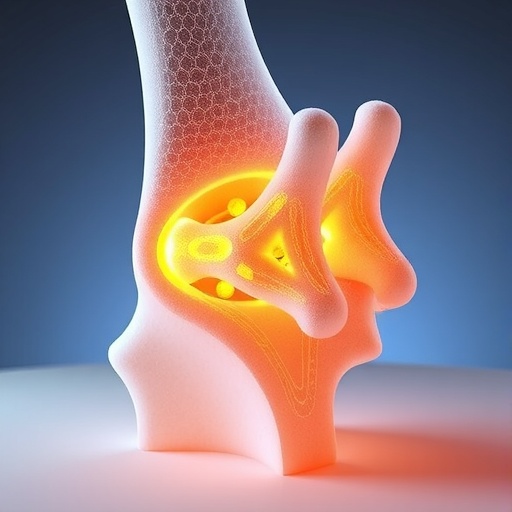In a groundbreaking advancement that could revolutionize cancer therapy, researchers have developed a novel bioengineered and biodegradable three-dimensional (3D) scaffold designed specifically for the controlled delivery of 5-fluorouracil (5-FU) loaded nanoparticles, targeting bone tumor treatment. This innovative approach addresses some of the longstanding challenges associated with delivering chemotherapeutic agents directly and effectively to malignant tissues within bone, thereby enhancing therapeutic efficacy while minimizing systemic toxicity.
The research, led by Ma, Shi, and Zhang, signifies a significant leap in the field of oncology and drug delivery systems. The newly fabricated 3D scaffold is composed of biomaterials that are both biocompatible and biodegradable, ensuring that the implant gradually breaks down within the body following its therapeutic action. The scaffold functions not only as a structural framework to support bone tissue regeneration but also as a reservoir for the anticancer agent 5-fluorouracil, encapsulated within nanoparticles engineered for sustained and controlled release.
One of the greatest challenges in bone tumor management has been the inability to maintain therapeutic drug concentrations at the tumor site for an extended period without causing severe adverse effects elsewhere in the body. Conventional chemotherapy suffers from systemic drug distribution, which can result in damaging healthy cells and tissues, as well as rapid clearance from the target area. The design of this 3D scaffold directly confronts these issues by localizing drug delivery, thereby maximizing the destruction of tumor cells while sparing healthy bone and surrounding tissues.
.adsslot_7gVGFylATc{ width:728px !important; height:90px !important; }
@media (max-width:1199px) { .adsslot_7gVGFylATc{ width:468px !important; height:60px !important; } }
@media (max-width:767px) { .adsslot_7gVGFylATc{ width:320px !important; height:50px !important; } }
ADVERTISEMENT
The researchers employed advanced fabrication techniques to construct the scaffold with a porous architecture, which is critical for mimicking natural bone tissue microenvironments. This porosity facilitates not only the infiltration of nutrients and oxygen necessary for cell survival and proliferation but also acts as a controllable network for the gradual diffusion of the encapsulated drug. Such a design mimics the extracellular matrix, providing mechanical support and biochemical cues to facilitate bone regeneration post tumor excision.
Nanoparticles loaded with 5-fluorouracil were intricately integrated within this scaffold matrix. 5-FU, a potent antimetabolite chemotherapeutic agent, interferes with DNA synthesis, thereby inhibiting the proliferation of rapidly dividing tumor cells. Encapsulation into nanoparticles serves to protect the drug from premature degradation and allows a sustained release profile, opening new horizons for targeted cancer therapy. The nanoscale delivery vehicle enhances cellular uptake and further modulates the drug’s pharmacokinetics and pharmacodynamics, achieving higher efficacy at lower dosages.
Extensive in vitro testing demonstrated remarkable cytotoxicity against osteosarcoma cell lines when exposed to the 5-FU-loaded scaffold, with controlled release profiles maintaining effective drug concentrations over several days. Importantly, the scaffold itself exhibited excellent biocompatibility, showing minimal induction of inflammatory responses and supporting the adherence and growth of healthy osteoblast cells. This dual action of killing tumor cells while promoting bone tissue regrowth is an ideal therapeutic paradigm in bone oncology.
The biodegradability aspect of the scaffold was engineered to carefully balance the degradation rate with tissue healing processes. Constructed from materials such as poly(lactic-co-glycolic acid) (PLGA) or similar bioabsorbable polymers, it ensures that once the scaffold has fulfilled its drug delivery and structural functions, it is gradually resorbed by the body into non-toxic metabolites. This eliminates the need for additional surgeries to remove implant materials and reduces long-term foreign body reactions, greatly improving patient outcomes and recovery experiences.
Furthermore, the controlled release kinetics were finely tuned by varying the nanoparticle composition and scaffold porosity to achieve a steady-state drug concentration—a delicate equilibrium that is critical for mitigating drug resistance, a pervasive challenge in chemotherapy. Sustained low-dose exposure of 5-FU circumvents the rapid development of tumor resistance mechanisms, potentially prolonging the therapeutic window and reducing the frequency of administration.
The applications of this technology extend beyond bone tumors. The modular nature of the scaffold design and the customizable nature of nanoparticle drug encapsulation permit adaptation for other localized cancers and diseases requiring site-specific drug delivery. Additionally, the incorporation of bioactive molecules alongside chemotherapeutics could usher in multifunctional platforms that promote angiogenesis, immune modulation, and enhanced tissue repair concurrently with tumor eradication.
Integrating multidisciplinary expertise ranging from materials science and nanotechnology to oncology and pharmacology, this study delivers a promising blueprint for next-generation cancer treatments. The coupling of 3D bioengineered scaffolds with nanoparticle drug delivery represents a convergence of regenerative medicine and targeted chemotherapy that can potentially redefine standard care protocols, offering personalized and precision medicine strategies.
The implications of this study resonate deeply within the global fight against bone cancers, which notoriously have poor prognoses due to late diagnosis and limited treatment options. By mitigating systemic toxicity and enhancing localized chemotherapeutic impacts, patients could experience fewer side effects and improved quality of life. The scaffold-based delivery system also holds promise for reducing healthcare costs by decreasing hospitalization times and the need for complex surgical interventions.
Moreover, the technology aligns with the burgeoning trend of personalized medicine where treatments are tailored not only to the genetic profile of tumors but also to the biological microenvironment of affected tissues. By customizing scaffold compositions and drug release patterns to individual patient needs, oncologists may soon harness this platform to deliver precisely what is necessary, when it is necessary—a dream long aspired but recently attainable.
This innovative drug delivery system also underscores the critical role of biomaterial engineering in modern therapeutics. The ability to recreate tissue-like environments capable of performing sophisticated biochemical functions represents a paradigm shift from traditional medicine towards smart, responsive therapies. The scaffold not only acts as a passive container but as an active participant in tissue regeneration and tumor suppression.
As the sphere of nanotechnology continues to expand within medicine, the fusion with biodegradable scaffolds embodies a holistic approach to treatment. Such platforms promise integration with diagnostic tools, bioimaging agents, and responsive drug release mechanisms triggered by local physiological stimuli, paving the way for truly dynamic and adaptive cancer therapy modalities.
The research by Ma and colleagues stands as a stellar example of how interdisciplinary efforts can translate fundamental scientific insights into tangible medical innovations. The potential impact on patient survival, morbidity, and overall healthcare dynamics is enormous, warranting attention from clinicians, researchers, and policymakers alike to support rapid advancement and integration into standard clinical practice.
In summary, this novel bioengineered biodegradable 3D scaffold loaded with 5-FU nanoparticles represents an exciting frontier in bone tumor treatment. Its capacity for localized, sustained drug release combined with biocompatible properties and structural support for bone regeneration holds promise for revolutionizing therapeutic strategies. Future developments and clinical translations could soon make such advanced implantable drug delivery systems standard practice, ultimately improving outcomes for countless patients worldwide.
Subject of Research: Bioengineered and biodegradable 3D scaffold for controlled drug delivery of 5-fluorouracil-loaded nanoparticles targeting bone tumor treatment.
Article Title: Bioengineered and biodegradable 3D scaffold for controlled drug delivery of 5-fluorouracil-loaded nanoparticle for bone tumor treatment.
Article References:
Ma, H., Shi, J. & Zhang, W. Bioengineered and biodegradable 3D scaffold for controlled drug delivery of 5-fluorouracil-loaded nanoparticle for bone tumor treatment. Med Oncol 42, 395 (2025). https://doi.org/10.1007/s12032-025-02891-2
Image Credits: AI Generated
Tags: 5-fluorouracil nanoparticlesbiocompatible scaffolds for drug deliverybiodegradable biomaterials for cancer treatmentbioengineered 3D scaffoldbone tissue regeneration techniqueschallenges in bone tumor managementcontrolled drug delivery systemsenhanced therapeutic efficacy in oncologyinnovation in cancer therapyminimizing systemic toxicity in chemotherapysustained release drug delivery mechanismstargeted bone tumor therapy





